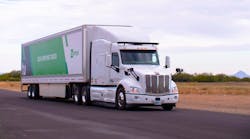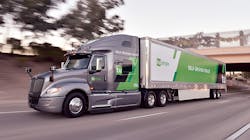For those wondering when self-driving trucks will hit the road, they should know that right now, autonomous truck startup TuSimple’s Class 8 semis — 40 in all — are rolling through the Southwest day and night. They are steered by a collaborative effort of cameras, radar and lidar sensors that feed data to an onboard artificial intelligence.
The trucks have accrued more than 1 million safe miles so far and run routes for UPS and McLane Co. There’s a human in the cab, of course, to manually drive at times, as these robotic trucks haven’t earned their independence quite yet and the technology isn’t 100% flawless. However, that day may be fast approaching as TuSimple continues generating momentum.
This year has been particularly momentous for TuSimple, as the company not only continues to refine its technology, but is rapidly amassing more infrastructure and industry partners. It has raised nearly $300 million, with UPS being an investor, and is looking for $250 million more in Series E funding.
The first domino to fall was creating the TuSimple Autonomous Freight Network (AFN), which envelopes the driverless trucks and autonomous operations monitoring system, along with digitally mapped routes and terminals. Partners include McLane, Penske, UPS, and U.S. Xpress.
Through a partnership with Navistar announced in July, the San Diego-based TuSimple expects the first commercially available tractors embedded with its solution that provides Level 4 autonomy – meaning that the truck drives itself under most but not all conditions — in 2024. These are expected to be Navistar’s International LT Series Class 8 semis.
“We’re just talking about getting off the highway, going to your local distribution center, which in most cases are one or two turns off the interstate,” Gutierrez told FleetOwner in July. Workers at the distribution centers would prep the trucks for their human-free journeys.
The startup founded in 2015 began its partnership with Navistar in 2018.
“With the combined expertise of Navistar and TuSimple, we have a clear path to commercialize self-driving Class 8 trucks at scale,” TuSimple CEO Cheng Lu said.
Building on that, TuSimple struck a bargain with the Traton Group to enter the European market. Scania trucks with TuSimple technology will run a hub-to-hub route between the Swedish cities of Södertälje and Jönköping, a length of roughly 100 miles. Traton is taking a minority stake in TuSimple. The Volkswagen AG subsidiary also has 16.8% ownership in Navistar, which it has made multiple attempts to wholly to acquire this year. In January the bid was $2.9 billion and in early September that was increased to $3.6 billion.
There’s a clear interest in TuSimple for what it promises to offer, and the pandemic only strengthens the case for automated freight delivery, which is also being pursued by Alphabet’s Waymo Via and Plus.ai. Fleet concerns about a dearth of drivers, truckers’ gripes with hours of service rules, and the general public’s worries about unsafe trucks on the road all feed the driverless truck revolution. Opposing forces include that same public’s general fear of robots steering heavy trucks and the lengthy process of outlining governmental regulations and industry standards.
There are a many questions that need to be answered, and FleetOwner recently connected with TuSimple’s chief product officer, Chuck Price, to answer a few of them.
[Edited for clarity]
FleetOwner: Are you still on track for the driverless International trucks in 2024?
Chuck Price: Correct. We are in the early stages of the Production Development Program. We’re scaling up, we’re hiring like crazy. We have 700 employees now.
FO: What’s the biggest challenge right now with that?
CP: The relationship between the startup and the OEM is like grabbing a tiger by the tail. We thought we were busy already just doing prototype development trucks. It is really a whirlwind of activity. These guys at Navistar have been doing this for 100 years and they have producing a truck down to a science. And there's a lot that goes into this. This is not an option like deciding you want cruise control. The nature of an autonomous system is that it touches many parts of the truck. It's a deeply integrated technology. The truck is designed for autonomy.
FO: Could someone add your solution to an existing truck?
CP: Some people were talking about taking off-the-shelf trucks and retrofitting a Level 4 solution. We’ve looked very hard at this problem. I don’t think any fleet would be satisfied with a retrofit vehicle, given the invasiveness of the change. You've got to touch everything from the electrical power generation system to the powertrain — everything. In order to be safe, it has to be a really tight integration with a lot of redundancies that you just don't find in a drive-off-the-lot truck.
FO: Navistar will be assembling the medium-duty electric truck, the eMV Series, in the spring of 2022 at its new San Antonio factory. Can we expect the first TuSimple trucks to be electric as well?
CP: It's inappropriate for me to talk about vehicle specifications at this time. The high level of autonomy, for the most part, is agnostic to what the power train is. There are features you can get with an electric powertrain that we would certainly leverage. And by the way, our system consumes a lot of electrical power, so nothing like having a big bank of batteries for the power.
FO: In a study TuSimple released, the driveress AI was shown to improve fuel efficiency by 10%. The prevailing thought in the industry is that driver behavior accounts for 10 to 30%. Can you talk about how the technology gets that efficiency?
CP: There are a lot of ways to save fuel. Just slowing down saves a ton of fuel. I believe slowing from 65 to 55 mph can be a 15% fuel savings by itself. But there are a lot of fleets we work with that say, “Don’t ever tell me to slow down!” Their job is to get goods somewhere fast. A lot of the benefit of an autonomous vehicle is it is faster because you don't have stop for a rest.
In this academic study done by the University of California San Diego, which we provided the grant money for, they instrumented trucks and studied human driving performance compared to autonomous driving performance, where everything else was the same. We did this for six months. They collected a lot of data and then did a statistical analysis and determined a 10% aggregate savings over many kinds of runs, [totaling 122 autonomous missions over 6,700 miles]. Separately, one of our fleets did their own study based on fuel log data we were providing for them and they recorded 9.4%, so we're very close to the theoretical number in practical use.
A big reason for the savings was that we're extremely stable laterally. So if you follow our truck, you'll never see any fishtailing of the trailer. Generally, human drivers are all over the lane. They get pushed by wind; they get pushed by the draft of other vehicles. We hold it to very high precision, and we can show with the data how precise it is, and how it varies from a human. And that not swerving back and forth in the lane, you’re saving fuel. You're also saving on tire wear, which is something we didn't think of at first, but it makes sense. Fleet maintenance folks told us we were going to save a lot on tires because we’re not scrubbing tires going back and forth in the lane.
We also have very good longitudinal control. We look far ahead; our system can perceive objects over half a mile away. With that range, we're able to achieve efficiencies that human drivers typically aren't doing. Also, we're far less aggressive on throttle and the brake. We work very hard to stay off the brake to keep the mass moving at a constant speed. We'll change lanes to avoid having to do lots of stop and goes.
So, we optimize movement making it a much more efficient.
FO: Testing right now is going from the Tucson to Dallas, which for the most part is a dry, flat stretch of desert. But there are flash floods and other inclement weather that can cause human drivers a lot of problems. Have your trucks experienced any of these yet, and what do they do?
CP: Part of our requirement is that we will detect a flooded road and stop. We won’t go through a flooded road.
These trucks can operate in the rain actually very well. Cameras are the primary sensor, with lidar and radar as secondary sensors. Lidar is affected very quickly when it starts to rain. The camera is not that way. We do have limits, but we can’t get into those yet. When it’s that time of year for thunderstorms, we get pretty excited because we can test more in heavy rain.
What also comes in these storms is heavy winds and side loads introduced onto a truck are very powerful. A trailer is just a giant billboard. We hold our track pretty well and our control can keep up with a driver’s.
And our trucks perform surprisingly well in dust storms, which are somewhat unique to the desert. Our autonomy was targeting better than our human driver who was rapidly trying to find a place to pull over.
FO: In trucking, safety is never supposed to be a competitive advantage, but a self-driving truck company’s technology is a competitive advantage, and the better the tech, the better the safety. On the other hand, any fatal accident by you or your competitors would be catastrophic setback for public acceptance. How do you navigate all this and share information and work on regulations that can save lives but not hurt your business?
CP: The community is pretty small, pretty tight. In terms of the company working on this problem, we know what each other is doing on many projects. For example, on regulatory things we touch at those points. Some standards are well defined, some of them are still being defined. Then, we collaborate with our competitors on notions of questions determining whether the system is safe enough to remove the driver.
You may find a startup or two bragging about being safer than the others. That’s not really the way the game’s played. We sort of shun those companies that we don’t think are operating safely.
We maintain a very open relationship with government agencies where we operate. The moment we started building out in Arizona, we engaged with the Arizona Department of Transportation, with the highway patrol, Department of Public Services, and the first responders. We engaged them on what do you want to see from us? How do we engage with you? What do you need to know? We share data. We bring them in, we let them climb on the truck. We take their advice. We’re all learning here. The regulators are trying to figure out how to regulate something like this.







